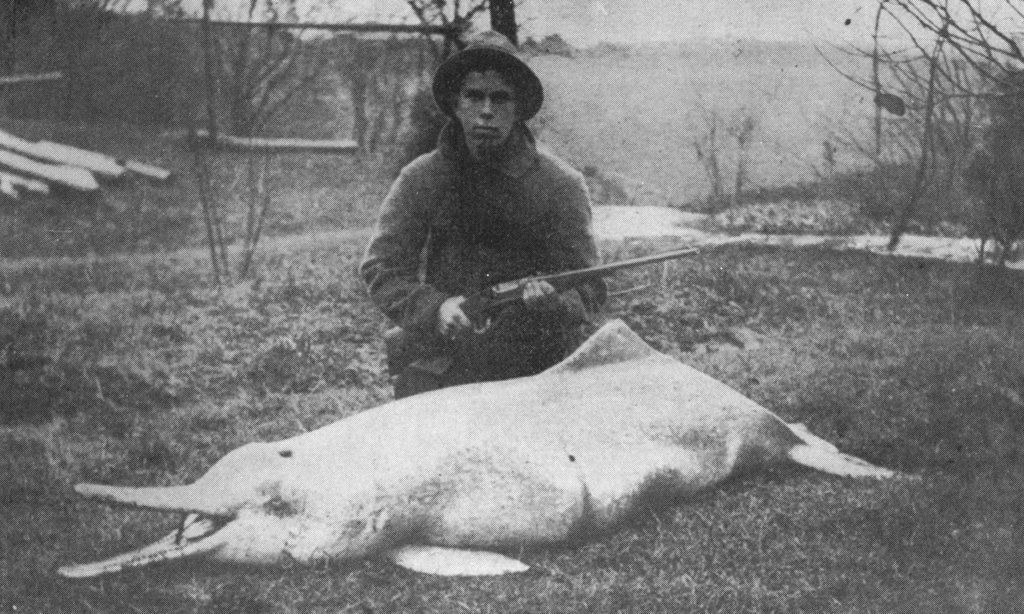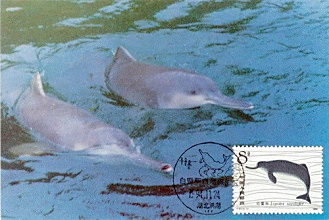|
Charles M. Hoy
Charles McCauley Hoy (1897–1923) was a field naturalist who obtained series of mammal and bird specimens for United States National Museum, travelling on expeditions to Australia, China and elsewhere. The large collections of specimens and notes he made in Australia from 1919 to 1922 followed a period of dramatic decline in its mammalian fauna, and have been examined by later workers in efforts to determine the causes of the event. Born in China to foreign missionaries, Hoy returned there in 1922 with a commission from W. L. Abbott to continue collecting specimens for the institution. His successful collecting in that region included becoming the first occidental researcher to obtain a species of rare river dolphin, but his works were curtailed by complications arising from childhood illness – while convalescing from a self-inflicted gunshot injury – and he died there in 1923. Biography Charles M. Hoy was the son of Christian missionaries from the United States of America ... [...More Info...] [...Related Items...] OR: [Wikipedia] [Google] [Baidu] |
Baiji Dolphin Killed By Charles Hoy 1914
The baiji (; IPA: ; ''Lipotes vexillifer'', ''Lipotes'' meaning "left behind" and ''vexillifer'' "flag bearer") is a possibly extinct species of freshwater dolphin native to the Yangtze river system in China. It is thought to be the first dolphin species driven to extinction due to the impact of humans. This dolphin is listed as “critically endangered: possibly extinct” by the IUCN, has not been seen in 20 years, and several surveys of the Yangtze have failed to find it. In China, the species is also called the Chinese river dolphin, Yangtze river dolphin, Yangtze dolphin and whitefin dolphin. Nicknamed the "Goddess of the Yangtze" (), it was regarded as the goddess of protection by local fishermen and boatmen. It is not to be confused with the Chinese white dolphin (''Sousa chinensis'') or the finless porpoise (''Neophocaena phocaenoides''). The baiji population declined drastically in decades as China industrialized and made heavy use of the river for fishing, transpor ... [...More Info...] [...Related Items...] OR: [Wikipedia] [Google] [Baidu] |
United States National Museum
The Smithsonian Institution ( ), or simply the Smithsonian, is a group of museums and education and research centers, the largest such complex in the world, created by the U.S. government "for the increase and diffusion of knowledge". Founded on August 10, 1846, it operates as a trust instrumentality and is not formally a part of any of the three branches of the federal government. The institution is named after its founding donor, British scientist James Smithson. It was originally organized as the United States National Museum, but that name ceased to exist administratively in 1967. Called "the nation's attic" for its eclectic holdings of 154 million items, the institution's 19 museums, 21 libraries, nine research centers, and zoo include historical and architectural landmarks, mostly located in the District of Columbia. Additional facilities are located in Maryland, New York, and Virginia. More than 200 institutions and museums in 45 states,States without Smithsonian ... [...More Info...] [...Related Items...] OR: [Wikipedia] [Google] [Baidu] |
Ellis Le Geyt Troughton
Ellis Le Geyt Troughton (born in Sydney on 29 April 1893; died 30 November 1974) was an Australian zoologist and mammalogist. Biography Ellis Troughton began to exercise his interest in mammals at fourteen years of age, taking a role at the Australian Museum in 1908. He continued to be employed there as curator after returning from military service as a stretcher bearer in the European war during the years 1917 and 1918. He retired from the museum in 1958. Works Troughton wrote '' Furred Animals of Australia'' in 1941, with illustrations provided by Neville W. Cayley; the publication date of the work was determined to be 1944. He was the first Honorary Life Member of The " Australian Mammal Society" and ''The Ellis Troughton Memorial Award'' is named for him. Amongst Troughton early works is a significant contribution to the study of bats, and at 33 years of age he composed the text for the section regarding the poorly known Australian Chiroptera in the volume titled ''The ... [...More Info...] [...Related Items...] OR: [Wikipedia] [Google] [Baidu] |
John Gilbert (naturalist)
John Gilbert (14 March 1812 – 28 June 1845) was an English naturalist and explorer. Gilbert is often cited in the earliest descriptions of many Australian animals, many of which were unrecorded in European literature, and some of these are named for him by those authors. Gilbert was sent to the newly founded Swan River Colony and made collections and notes on the unique birds and mammals of the surrounding region. He later joined expeditions to remote parts the country, continuing to make records and collections until he was killed during a violent altercation at Mitchell River (Queensland) on the Cape York Peninsula. Early life John Gilbert was born on 14 March 1812 in Newington Butts, south London, England and was christened on 25 October 1812 at Spa Fields Lady Huntingdons, Clerkenwell, London. His father was William and his mother Ann, who were from nearby villages in Kent. Gilbert was a taxidermist for the Zoological Society of London, where he met John Gould. Gould had ... [...More Info...] [...Related Items...] OR: [Wikipedia] [Google] [Baidu] |
Lipotes Vexillifer
The baiji (; IPA: ; ''Lipotes vexillifer'', ''Lipotes'' meaning "left behind" and ''vexillifer'' "flag bearer") is a possibly extinct species of freshwater dolphin native to the Yangtze river system in China. It is thought to be the first dolphin species driven to extinction due to the impact of humans. This dolphin is listed as “critically endangered: possibly extinct” by the IUCN, has not been seen in 20 years, and several surveys of the Yangtze have failed to find it. In China, the species is also called the Chinese river dolphin, Yangtze river dolphin, Yangtze dolphin and whitefin dolphin. Nicknamed the "Goddess of the Yangtze" (), it was regarded as the goddess of protection by local fishermen and boatmen. It is not to be confused with the Chinese white dolphin (''Sousa chinensis'') or the finless porpoise (''Neophocaena phocaenoides''). The baiji population declined drastically in decades as China industrialized and made heavy use of the river for fishing, transportati ... [...More Info...] [...Related Items...] OR: [Wikipedia] [Google] [Baidu] |
Journal Of Mammalogy
The ''Journal of Mammalogy'' is a bimonthly peer-reviewed scientific journal published by Oxford University Press on behalf of the American Society of Mammalogists. Both the society and the journal were established in 1919. The journal covers research on mammals throughout the world, including their ecology, genetics, conservation, behavior, systematics, morphology, and physiology. The journal also publishes news about the society and advertises student scholarship opportunities. See also * Barbara Hibbs Blake Barbara Hibbs Blake (August 6, 1937 – August 18, 2019) was an American mammalogist and college professor. Early life Barbara Jo Hibbs was born in Roseburg, Oregon, the daughter of Gordon Reid Hibbs and Marybelle Hauskins Hibbs (later Ramsby ... * '' Mammalian Species'' References External links * * Academic journals associated with learned and professional societies Bimonthly journals English-language journals Mammalogy journals Publications established ... [...More Info...] [...Related Items...] OR: [Wikipedia] [Google] [Baidu] |
US Museum Of Natural History
The National Museum of Natural History is a natural history museum administered by the Smithsonian Institution, located on the National Mall in Washington, D.C., United States. It has free admission and is open 364 days a year. In 2021, with 7.1 million visitors, it was the eighteenth most visited museum in the world and the second most visited natural history museum in the world after the Natural History Museum in London."The World's most popular museums", CNN.com, 22 June 2017. Opened in 1910, the museum on the National Mall was one of the first Smithsonian buildings constructed exclusively to hold the national collections and research facilities. The main building has an overall area of with of exhibition and public space and houses over 1,000 employees. The museum's collections contain over 145 million specimens of plants, animals, fossils, minerals, rocks, meteorites, human remains, and human cultural artifacts, the largest natural history collection in the wo ... [...More Info...] [...Related Items...] OR: [Wikipedia] [Google] [Baidu] |



_(19728235004).jpg)

